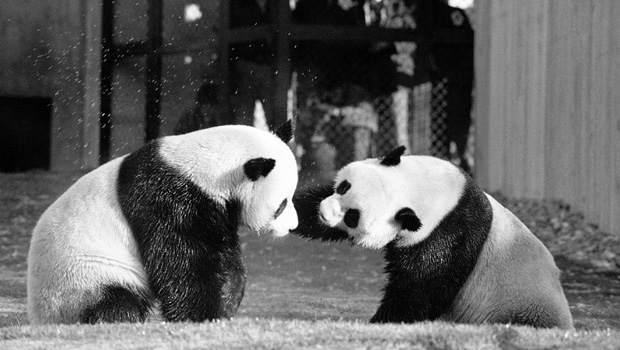Saving the giant pandas
"OH, BEI BEI!" Or so the admirers of one famed Washington, D.C., toddler might well exclaim. Rita Braver has the baby pictures:
OK, Moms, let's face it: this baby may be cuter than yours ... and a lot more famous.
He's Bei Bei, born at the Smithsonian Institution's National Zoo in Washington, D.C., last August. His arrival made headlines, even though he wasn't much to look at then. At birth -- pandas are born deaf, blind and hairless -- he was about one nine-hundredth the size of his mother. "They're really, really tiny," said pandakeeper Marty Dearie. "But they're really tough. Holding them in your hand, you'd be surprised at how sturdy they feel."
Dearie is one of about two dozen employees (aided by 60 volunteers) who keep the giant pandas happy and healthy.
Bei Bei will stay with mother Mei Xang until he's about two. Father Tian Tian and big sister Bao Bao have their own separate, specially-designed habitats, as pandas are usually solitary creatures.
Almost every move they make is captured by the zoo's famous Panda Cams.
Remember when this video of Bao Bao went viral last winter?
Braver asked, "Did the zoo have any idea how popular the Panda Cams would be?"
"I don't think anybody could predict the incredible popularity," said Brandie Smith, who oversees the zoo's panda operation. "But what I love is the fact that this is science, in real life, in real time."
Smith says the cameras help volunteers keep detailed logs of each animal's daily activities
"Right now we're looking at Mei Xang and Bei Bei to look at mother-cub interactions," said Smith, "hoping we can learn from that, and hoping we can help make more pandas in the future."
More pandas, because they are a highly-endangered species. Found only in China, there are only about 1,800 in the wild, as humans have encroached on their territory.
- Global warming expected to drastically reduce giant panda habitat (01/12/15)
- Oldest ever giant panda celebrates 37th birthday with bamboo, cake (07/28/15)
- Gallery: Inside a panda sanctuary
So the pandas at the National Zoo get frequent checkups, and in a rare, behind-the-scenes visit, Braver got to see how they are trained to cooperate...
Biologist Laurie Thompson coaxed Bei Bei to weigh in: "Good boy, get all the way ... I don't think you're in the middle of the scale." The outcome: 43-and-a-half pounds.
The reward: a sweet potato.
"Am I allowed to pet him?" Braver asked.
"No!" Thompson laughed. Yes, these cuddly creatures can bite.
At almost 3 years and 175 pounds, Bao-Bao (Bei Bei's sister) does her training through a cage, in exchange for a delicious stream of honey water.
It's how she grows accustomed to everything from dental exams to blood tests, according to pandakeeper Tallie Wiles.
"So if you do a blood stick, does it hurt her?" asked Braver.
"She might feel it initially, like a little pinch, like a person does," Wiles said. "And of course she's getting that honey reward, which is more fantastic than anything she's going through."
It was "Panda Diplomacy" that brought the first two pandas to the National Zoo. Hsing-Hsing and Ling-Ling were a gift from the Chinese Government in 1972, after President Nixon's historic visit to the country. But that panda pair never produced a cub that survived.
In contrast, Bei Bei's parents, who are here on loan from the Chinese Government, have produced three healthy cubs (including Tai Shan, now almost 11 and living in China).
But it hasn't been easy.
"The giant pandas are a species that is very difficult to reproduce and care for in captivity," said Steven Monfort, director of the Smithsonian Conservation Biology Institute in Front Royal, Va., "primarily because our knowledge of their biology has been very rudimentary until the last decade or so."
The Institute's key mission is studying panda reproduction.
"The female only matures and ovulates one time per year," said Monfort. "So you have about a 36-hour window of fertility once a year with a giant panda."
By collecting urine samples, researchers have been able to pinpoint exactly when Mei Xiang is fertile, and ready for a visit from Tian Tian.
But so far, they haven't been able to "connect the parts."
"That's a nice way of putting it," Monfort said. "There's an anatomical mismatch, let's say."
To tell you the truth, ladies, it's apparently a performance issue on the male panda's part. So, Bei Bei was conceived via artificial insemination.
Sadly, his twin did not survive, but every panda that makes it is considered a minor miracle.
"They're still under threat, and so we are in a race against time," said Monfort. "We have much, much more work to do."
Bao Bao and Bei Bei will be sent to China within a few years, so we should enjoy them while we can. And the Zoo's Brandie Smith says there's a primal reason why we are so delighted by the antics of these creatures:
"When you see something that touches your heart, there's a biochemical reaction -- you produce the same chemicals associated with childbirth. They make you happier. You become a better person by watching those pandas."
For more info:



